@GreenMoms Take On Cosmetics: Safe or Unsafe? And Should We Support the Safe Cosmetics Act?: It’s the Green Moms Carnival!
We’ve got a wonderful round-up of posts from members of the Green Moms Carnival, women who have been following the debate about cosmetics ingredients for years, and have interesting stories to share.
Let’s start off with Diane MacEachern of Big Green Purse. Diane blogs “evidence is emerging that the cumulative use of these products may be contributing to asthma, the onset of puberty in girls as young as three years old, and even the feminization of baby boys. Because cosmetics, soaps and shampoos are washed down the drain, they get into our water system, where they’re wreaking havoc on wildlife. And what about their relationship to breast cancer?”
But Diane doesn’t leave us hanging – she gives three common-sense ways we can reduce our exposure to the potential risks of cumulative exposure to low doses of chemicals.
Beth Terry of Fake Plastic Fish tells the story of why she tried to get away from a cute seat mate on a recent flight. “His Axe cologne, or whatever heinous product he was wearing, made my eyes water, nose itch, throat close up, and left me with a throbbing headache.”
That’s something I’ve experienced as well. Once you stop using synthetic fragrances, it’s hard to even be around them. A walk down a grocery store aisle – or a whiff of last year’s BlogHer room drops – can leave you feeling miserable.
Lisa from Condo Blues recounts an interesting discussion with a research scientist from a personal care company.
“One of the biggest secrets about what chemicals (or not) is in a product is what makes up the product’s fragrance,” she notes. “Last summer, I had the chance to talk to a representative from a large personal care company. She claimed that even her company didn’t know what was in the fragrances of their products because they buy the fragrance from a special fragrance house that has a super secret formula and ironclad nondisclosure agreement that says the fragrance house won’t tell the company what’s in the signature scent of their brand of shampoo.”
Katy at Non-Toxic Kids makes a case for showing The Story of Cosmetics to friends who may be unfamiliar with the battle for safer cosmetics. As she puts it, “Why should you care? There is a growing body of research showing links between many of the chemicals in our personal care products and serious diseases and conditions. Chemicals like triclosan, phthalates, parabens are in most cosmetics. Phthalates are often labeled as “fragrance”. Triclosan is labeled as an “antibacterial.”
And no one is looking at their synergistic effect on our bodies, especially those who are developing and growing at rapid rates: our children. The companies who make these products are using many chemicals that have never been independently tested for safety. That’s right, never.”
Linda from Citizen Green presents a well researched post that follows-up on Katy’s assertion. As Linda blogs, “Only 11 percent of the 10,500 ingredients in personal care products have been assessed for safety by the cosmetics industry.”
And that’s the reason Deanna of Crunchy Chicken blogs, “Make sure you start checking your product labels!”
Karen of Best of Mother Earth pulls no punches when she asks, “How can cosmetic companies like Estee Lauder raise funds for cancer research and produce products with carcinogens in them? Shouldn’t they start in their own back yard and produce a safe cosmetic in the first place?”
I always especially enjoy the contributions of our Carnival members from outside the United States. In Amber’s post at Strocel.com, Story of Cosmetics: Canadian Edition, she blogs about the situation in Canada – how in some ways it parallels the situation in the US, and yet how there are subtle differences. For example, Canadian cosmetic makers are required to list ingredients – “but not all of them.” Huh? So what good does that do? But Amber’s main message is one that is universal:
“But we must recognize that the beauty industry is trying to sell us stuff, just like any other industry that markets consumer goods. They want us to believe that we are flawed and need their stuff. If we aren’t concerned about the state of our skin or the shininess of our hair, we’re not going to shell out for products to fix them. Even initiatives like the Dove Movement are marketing campaigns aimed to make us feel favourable towards a certain brand.
My daughter Hannah is 5 years old. I don’t want her to feel that she needs to coat herself with stuff to be OK, and I especially don’t want the stuff she coats herself with to contain toxins. That’s why I want to see change in the cosmetics industry.”
I always see myself in Micaela’s (aka Mindful Momma’s) posts. Maybe it’s because we have kids around the same age, and while we are passionately committed to living sustainably, too often our lives intersect with the real world of Toys R Us and Pokemon.
In her post, “Maybe I Just Bought the Wrong Stuff,” Micaela blogs, “In The Story of Cosmetics, Annie Leonard comes out and says what a lot of us might be thinking when it comes to buying cosmetics and personal care products: “maybe it’s my fault…maybe I just bought the wrong thing”…meaning it’s our own damn fault for buying personal care products loaded with toxins and petroleum products…because we didn’t take the time to research the hell out of them before we went to the store.
I’m telling you – that is often how I feel. And it’s very frustrating.”
Frustrating? Lisa from Retro Housewife Goes Green goes even farther when she blogs, “I don’t know about you but I’m pissed off at the amount of work I have to do to keep myself and my family safe from cancer causing chemicals. We need to change the whole system and work together to demand safer cosmetics.”
I’m with Lisa – the whole system needs to change, and in my opinion, that includes regulation. But I’m not so sure the Safe Cosmetics Act is the answer. Check my post out here, where I blog about what I’ve learned in two years of following these issues – the things people inside the industry have told me – and my surprise and concern about the backlash opposition to the Safe Cosmetics Act that is being led by small, independent cosmetics makers.
Jennifer Taggert of The Smart Mama (and an attorney) voices her concern that the Safe Cosmetics Act may mean for small businesses. Jennifer has a unique take on this, and her full post is worth a close read. Here’s an excerpt:
“I bring the CPSIA up after watching The Story of Cosmetics because well intentioned legislation can go badly wrong.
That doesn’t mean that I don’t urge you to understand what it is you are buying. To adopt the precautionary principle in your purchasing decisions.
That doesn’t mean that I don’t think we should advocate for sensible legislation and regulations.
But that’s it – the legislation and/or regulations must be sensible. And that is hard to do. The devil is in the details. Overbroad legislation has unintended consequences and collateral damage.
As said by Supreme Court Justice Louis Brandeis:
The greatest dangers to liberty lurk in insidious encroachment by men of zeal, well-meaning but without understanding.”
What do you think?
Leave a comment and let us know!
And did you know you can get ALL of our posts pushed out to you via Twitter? Just follow us here: http://www.twitter.com/GreenMoms
— Lynn
Copyright 2010 OrganicMania
My Story of Stuff: The Stuff Industry Insiders Have Told me About the Battle over Safe Cosmetics
For two years I’ve been blogging about whether we really need government regulation of the chemicals commonly used in both personal care products and household care products.
I’ve not just been blogging, as I’ve shared here, but asking questions of just about everyone I’ve come across who has a connection to the chemicals and personal care industries.
I first went directly to the source. But Johnson & Johnson – who spends millions “courting bloggers” according to this Ad Age article – wouldn’t answer my questions about chemicals reform – even after a phone conversation, email, and a blog post. (Maybe they’ll answer my questions next week, when I see them at BlogHer).
And the industry council, The Personal Care Products Council? They wouldn’t talk either.
So I asked a professor of environmental science about the issue. “It’s bad,” she said. “Really bad. Nobody really knows what the impact is of all these chemicals.”
I stood up at the annual meeting of the Soap and Detergent Association and asked my questions. All I got in return was a bunch of non-answers from a lawyer who was clearly trying to evade the issue. It was frustrating, and it caused my skepticism to grow.
I asked the chemicals industry consultant who sat across the aisle from me on a long plane ride. Just like the professor, he acknowledged that the industry really doesn’t know the cumulative impact, but it didn’t look good. They could go with other chemicals, but they’re more expensive and it’s a cumbersome process to change.
“Why don’t they resolve it within the industry and avoid regulation?” I asked. “The regulatory process is just a waste of tax payer money. Industry could do a better job of fixing the problem anyway than via government oversight.”
“I tried to get them to do that,” he said. “But they’re afraid of litigation. If one company admits that there’s a problem with their ingredients, the lawyers will come after them.”
Here was a guy who was clearly frustrated – and disgusted.
The fact is, there’s no incentive to find out what the cumulative impact is of repetitive exposure to everyday chemicals. There’s disincentive.
The introduction of the Safe Chemicals Act purports to change that. Its supporters tied the launch to the debut of a controversial new video by Annie Leonard of “Story of Stuff” Legend. In just 10 days, it’s already racked up nearly 200,000 views.
But just like the truth, the stories I’ve been told are not all one-sided.
There was the brilliant toxicologist who spent 30 minutes with me, discussing the issues in the clear, straightforward way that is common to really bright people who can distill an issue down to its simplest elements.
He denied that his company made one version of product for sale in the EU, where chemical laws are tougher, and a different version in the US.
He also railed against the EWG, saying that their database distorts science and scares people (essentially the same arguments the formaldehyde lobby made on my blog, but stated in a much nicer way!)
And he’s not the only one. Quietly, even organic and natural beauty advocates say the same thing.
Has the EWG stretched their case to make a point? Perhaps.
But would we have come this close to having government re-examine the safety of our everyday products were it not for the efforts of the EWG? Of course not.
Just five days ago, a rebuttal was posted to The Story of Cosmetics. Far from 200,000 views, The Critique of The Story of Cosmetics has attracted just 12,750 views. But of course I watched it just to see if it answers my questions.
It didn’t. Never does the critic address the central issue at stake: what is the impact of the cumulative exposure of these chemicals?
I read the response issued by the Personal Care Products Council to the Annie Leonard Film. It doesn’t address the issue either.
And now I feel confident I know why.
They just don’t know.
It’s not how business works. Each company is worried about its own products – not the interaction of their products with others.
So what can a consumer do?
1. Use fewer personal care products, particularly if you’re pregnant or someone who may wish to become pregnant (or impregnate someone! – yes, chemicals like phthlates have been linked to decreased sperm count). Avoid personal care products for infants and young children.
2. Consider products that can be used for more than one purpose. (Guess what? Most of the “special uses” are all about marketing anyway!)
3. Think organic and natural (yes, I realize they contain chemicals, but not the types of chemicals that are linked to hormone disruption).
It’s all very confusing. And to make things even more so, a coalition of independent cosmetics makers (you know, the sweet ladies who sell natural and organic make-up on Etsy and at the local fair) have come out in opposition to the Safe Cosmetics Act. They’re concerned that the bill’s requirements will put them out of business. While the supporters of the SCA dispute that, it’s easy to sympathize with these women. After all, it wasn’t long ago that the government made a mess of CSPIA legislation, driving similar small businesses (consignment shops and the like) out of business.
Thanks for reading this far! A long post I know, and without all the links, which I’ll add in shortly!
I want to hear your thoughts as well. What do you think about the debate over cosmetics and the SCA?
This post is for the Green Moms Carnival on Cosmetics, to be hosted here at OrganicMania.
— Lynn
Copyright OrganicMania 2010
Filed under Uncategorized | Wordpress Comments (13) |Power Outage: What Would You Save From Your Fridge?
As if the blizzard, earthquake, and 106 degree heat were not enough weather related wackiness for the DC area, we were struck with 80 mph winds yesterday which left 250,000 people (including yours truly) without power.
As luck would have it, I had just bought enough organic, natural and rGBH-free ice cream to last the summer. “Savings!” I told my husband. “I stocked up! And I’ll blog about it!”
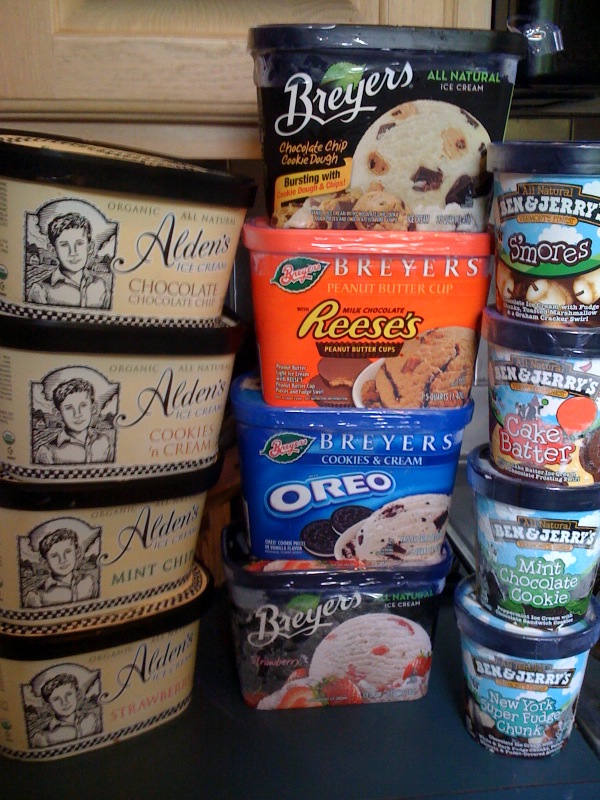
Then the power went out.
Our neighbors walked around picking up the branches and trees that littered our streets.
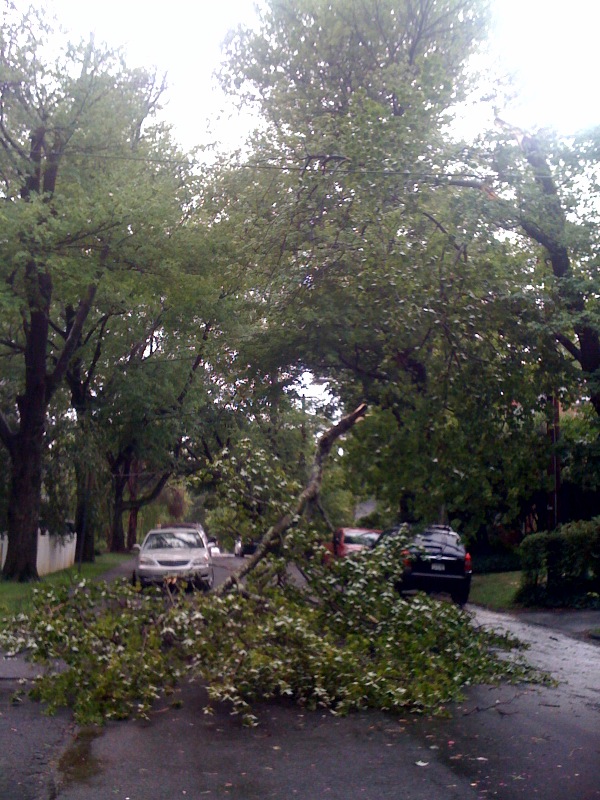

People gawked at the downed power lines and exploded asphalt.
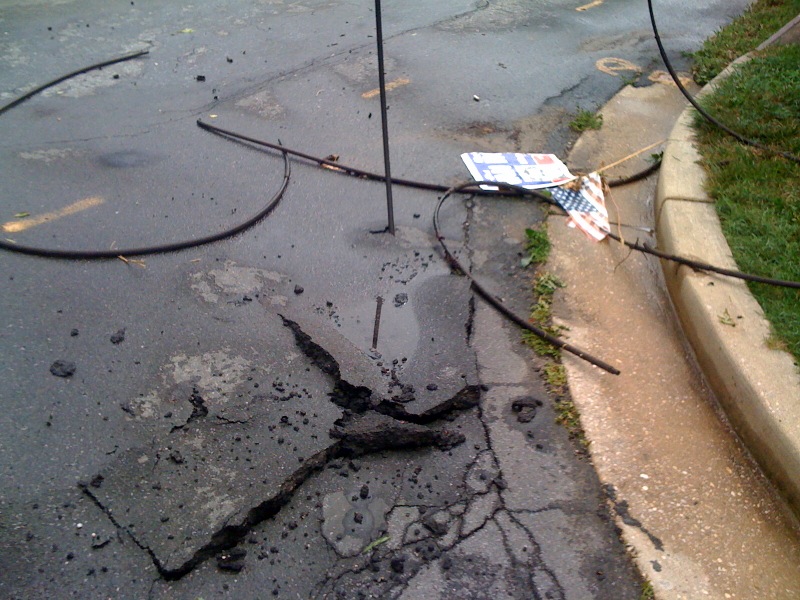
And I went into party planning mode.
Less than an hour later, the ice cream was loaded up on the little red wagon.

The neighbor girls made a sign.
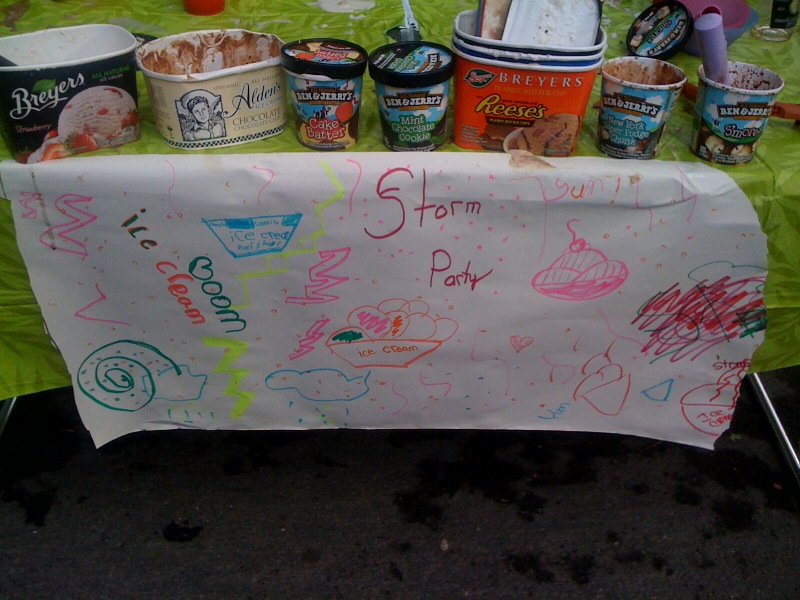
And our block partied down.
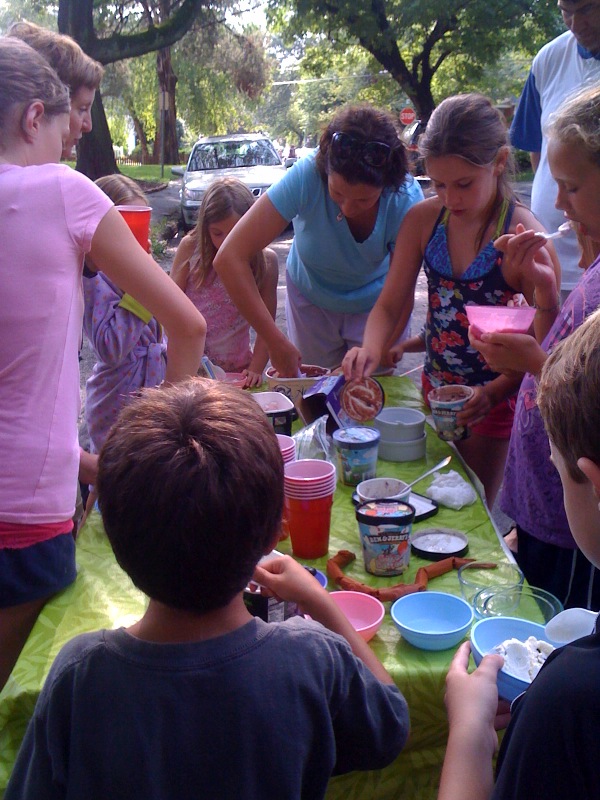
But what about the rest of the food?
I wasn’t optimistic that our power would be back on soon. After a bad storm last winter, some people were left without power for more than a week. Two thirds of my zipcode is without power!
We were headed to a lucky neighbor’s home – they still had power. And we had two large freezer chests to fill. Our fridge was overflowing.
Here’s what I took:
– The Ayrshire Farm organic chicken I bought at My Organic Market. I’ve been to a chicken tasting at this farm, and the chickens live better lives than most people. It’s like the Versailles of chicken farms.
– Organic milk.
– Some wonderful provisions from our biodynamic CSA: home made butter, biodynamic eggs and biodynamic yogurt from Seven Stars Farm;
– Whole Foods rotisserie chicken;
– Applegate Farms anti-biotic free turkey bologna;
– Organic frozen veggies
What would you save from your fridge?
And the second part of the ice cream series? Coming soon, I promise! My schedule has been – interrupted! (As well as some great pix from the party, which you can find on my twitter stream @organicmania or my twitpic account!)
— Lynn
Filed under Bethesda | Wordpress Comments (6) |Keeping Cool with Ice Cream: How to Save, What to Buy (Part 1)
It’s one of the most frequent questions I’m asked. “If I can’t afford to buy everything organic, what should I buy organic?” My response: it depends on what you eat most often.
And in summer, when I declare ice cream “the divine right of children,” ice cream becomes a basic food group. (Particularly on days like today, when my car’s therometer hit 106 degrees.)

But the $5.69 price tag on a half gallon of organic ice cream can cause the most devoted organic fan to pause. I wondered if I was really spending my money wisely, so I decided to take a closer look at the prices and ingredients of some popular ice cream brands.
My neighbor is a big fan of Edy’s. It’s what she served at a recent Cub Scout picnic (you remember — the one where the parents covertly drank wine from water bottles). I wondered if I was a fool for shelling out $5.69 for Alden’s organic ice cream, when the kids seemed perfectly happy with the $2.69 per gallon Edy’s (And they do have a really cool spumanti flavor). So I took a closer look at Edy’s ice cream ingredients, and in addition to the usual milk, cream, and sugar, here’s what I found:
- corn syrup;
- mono and diglycerides (what the heck are they?);
- partially hydrogenated oils (you know, transfats!); and
- Yellow #5 and Blue #1 (also known as artificial colors).
Ick. Corn syrup’s bad enough, but artificial flavors and trans-fats are on nearly every Mom’s “avoid” list – organic fanatic or not.
And think about it. That’s just what they’re required by law to list. No where will you see that the milk came from cows treated with hormones or the corn from pesticide laden fields – we can just infer that, because it’s not organic.
When I went to Edy’s web site to double check the ingredients list, I found another fun fact: Edy’s (along with Dreyer’s) is owned by Nestle, a company whose products many of us try to avoid.
What’s in the organic ice cream I love? Nothing I can’t pronounce. Just simple, wholesome ingredients that are organic – which means there’s no hormones, no pesticides, and no Genetically Modified Organisms.
And a bonus discovery was learning that instead of being owned by a controversial global conglomerate, Alden’s is family owned. It’s part of the Oregon Ice Cream Company, which has been making ice cream for 80 years.
Now here’s the really good news. When I was at Whole Foods River Road in Bethesda on Friday, Aiden’s was on sale for $5.19 a gallon, until July 27th. So now’s the time to try.
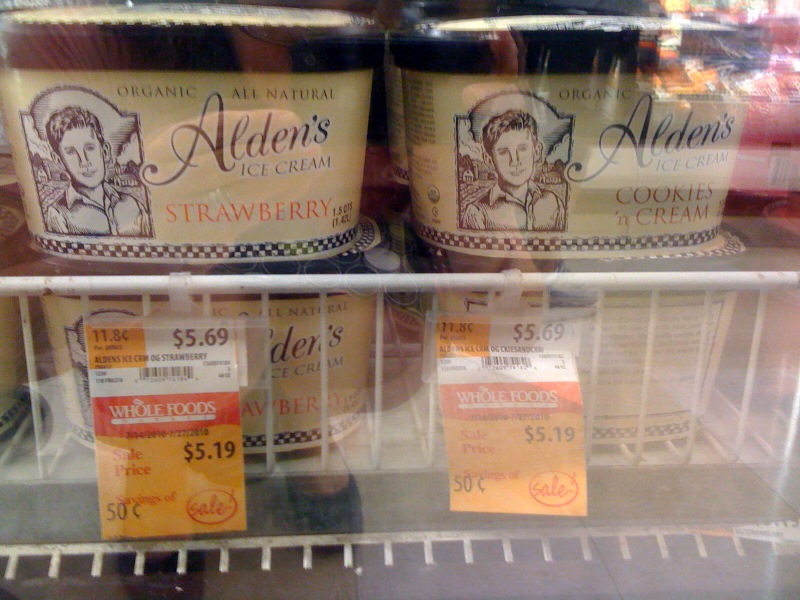
Alden's organic ice cream on sale at Whole Foods
Of course I’m not a total zealot. My kids buy ice cream from the Good Humor man. And I do buy other brands of ice cream from time to time. But let’s talk about that in my next post, when we’ll look at how organic ice cream stacks up to my childhood favorite, Breyer’s, and cult favorite Ben and Jerry’s.
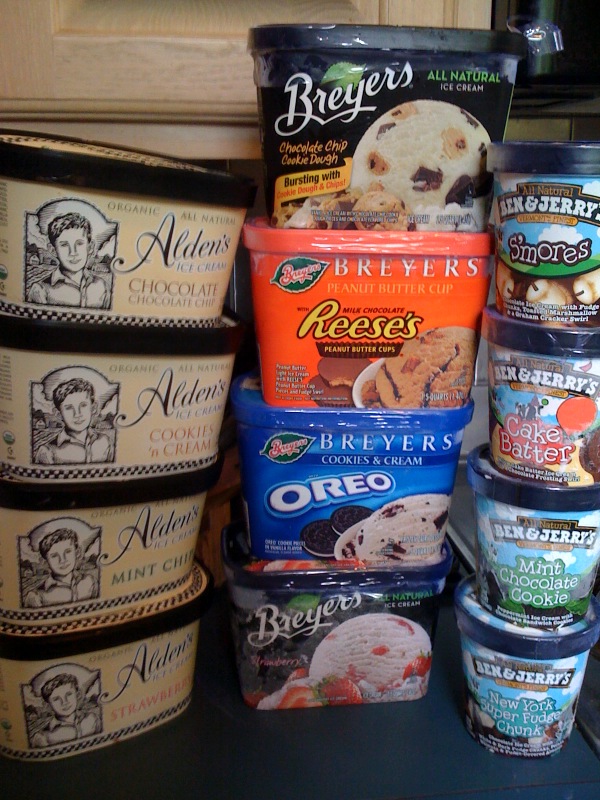
Stack em up: Alden's Organic vs. Breyer's All Natural vs. Ben & Jerry's rGBH free ice cream
Meanwhile, stay cool in this heat wave!
— Lynn
Copyright 2010 OrganicMania
Disclosures: I am one of those endangered species of bloggers that actually blogs about things I buy with my own money. No one sent me ice cream. A PR rep didn’t pitch this story. I’m not consulting for any of these companies. I just love ice cream, love organics, and love blogging about both and thought I’d share with you!
Filed under Bethesda, Food, Organic Prices, Organics, Organics vs. Conventional Foods, Product Recommendations, Savings Tips, Where to Buy Organics, Whole Foods | Wordpress Comments (13) |NO, Of Course I Didn’t Buy That “Organic” Shampoo & Then Tell The New York Times About It!
Well, it is true that I did tell a New York Times reporter that I was “furious” about a so-called “organic” shampoo that was anything but organic – or even natural. I even sent him the blog post I wrote about it, which you can read here. In the post, I wrote about how I picked up the “organic” lice shampoo and then realized it was anything BUT organic.
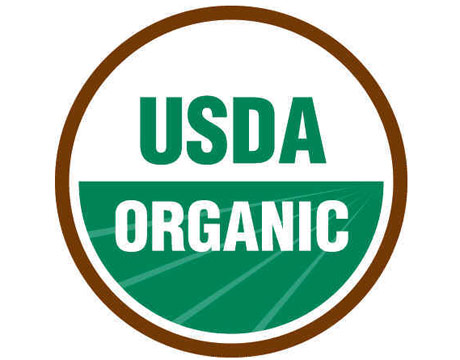
“But skeptic that I am, the first two things I do when I see anything labeled “natural” or “organic” is to check the ingredients list and to look for a USDA organic certification label. Despite the “organic” claims, I didn’t see a USDA label on the Fairy Tales bottles, but I did see a long list of non-organic ingredients including major no-nos like parabens and fragrance.
According to the Environmental Working Group, “parabens can disrupt the hormone (endocrine) system, and were found in the breast cancer tumors of 19 of 20 women studied.” And the EWG reports that fragrance should be avoided in children’s products because of allergens that may contain neurotoxic or hormone-disrupting chemicals. (You can learn more about fragrance through this informative EWG video clip).”
So yes, it’s kind of a thrill to see myself quoted in The New York Times. But honestly, anyone who reads my blog posts or tweets knows that I would NEVER buy an “organic” product that does not have the USDA Organic Seal or the new NSF/ANSI 305 seal. (My original post pre-dated the introduction of the NSF seal).
That’s also why I wrote, “So dear readers, please look for the USDA Organic seal and READ LABELS on personal care products, especially those marketed to children or used by women during childbearing years.”
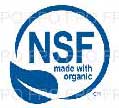
You may wonder why I was “furious” if I didn’t buy the product. I’m still furious. I’m furious that companies greenwash and prey on mothers’ fears, urging them to buy products that are not what they are promoted to be – organic. Mothers look for organic products because they (correctly) believe them to be purer and safer for their kids than products that are not organic. As I told the reporter, I’ve been saddened to see organics pioneers (many of them women) work long and hard to bring truly organic products to market – only to have their USDA certified organic products shelved next to fakers – products with organic on the label but synthetic ingredients inside. Of course they’re cheaper! They’re easier to make!
I’m glad that Whole Foods is cracking down on this, but I’m not entirely optimistic that things will change without a major education campaign from the Organic Trade Association. Surveys have shown that consumers believe “natural” is better than organic – even though there are no standards governing the use of the word “natural.”
So – looking to go organic? Look for the USDA Organic label or the NSF/ANSI305 label.
Anything else? Well, it’s just Greenwashing at the Kiddie Hair Salon (not the supermarket, as quoted!)
— Lynn
Copyright OrganicMania 2010
Filed under Organic Personal Care Products, Organic Product Needs, Whole Foods | Wordpress Comments (11) | My StumbleUpon Page
My StumbleUpon Page



